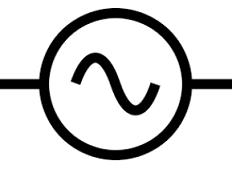Before establishing the meaning of the term alternating current, it is necessary to discover the etymological origin of the two words that give it shape:
-Current derives from Latin, exactly from "currens, currentis", which can be translated as "he who runs." It is the result of the sum of two clearly delimited components: the verb "currere", which is synonymous with "run", and the suffix "-nte", which means "agent".
-Alterna, on the other hand, also derives from Latin. In its case, it comes from the word "alternus", which is synonymous with "that follows another in a successive manner." It is formed from the union of three parts: "alius", which means "other"; the contrastive suffix “-ter” and the suffix “-no” used to indicate belonging.
To understand what alternating current is, we must first understand certain basic notions linked to electricity .
 Subatomic particles such as protons and electrons have an electrical charge , a physical property that is manifested by the forces of repulsion and attraction that exist between them. The flow of electrical charges through a conductor is called electric current .
Subatomic particles such as protons and electrons have an electrical charge , a physical property that is manifested by the forces of repulsion and attraction that exist between them. The flow of electrical charges through a conductor is called electric current .
If the flow of electric current changes direction from time to time, it is called alternating current . On the other hand, when the direction remains constant despite the passage of time, it is direct current .
Also known as AC by its acronym or AC by the English expression alternating current , alternating current usually oscillates in a sinusoidal manner, a peculiarity that allows for greater efficiency in the transmission of energy . In any case, there are also other oscillations: square, triangular, etc.
The distribution of electricity to homes and industries is usually carried out with alternating current. This is because its transformation is simpler compared to direct current. With a device known as a transformer , the voltage of alternating current can be increased efficiently and easily.
A transformer, in this framework, can increase the voltage and generate high voltage while the current intensity decreases. Thus the energy can be distributed over long distances with a low current intensity and thus with low losses. When the point of consumption is reached, the voltage can be reduced again for safe use of electricity.
In addition to everything stated above, we cannot ignore another series of interesting data about alternating current such as these:
-It is the current that we can find in home sockets.
-It is the easiest to generate and also to carry from one place to another. Hence it is the most common as well.
-It is considered that in alternating current, the intensity changes direction of circulation approximately 50 times per second.
-When making calculations with alternating current, a series of essential values become relevant such as the maximum value, the crest value or also called peak, the instantaneous value, the effective value, the peak-to-peak value...
